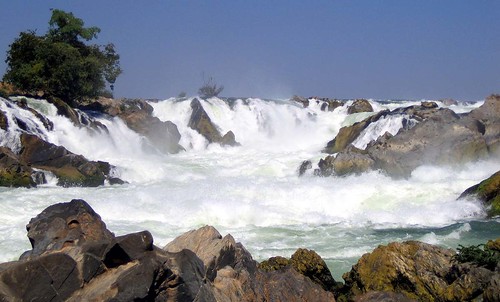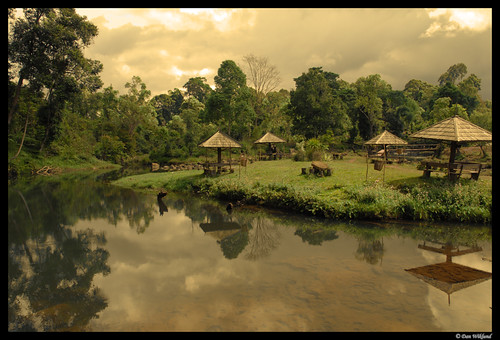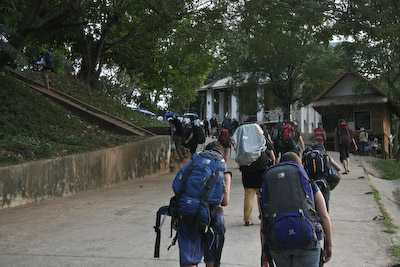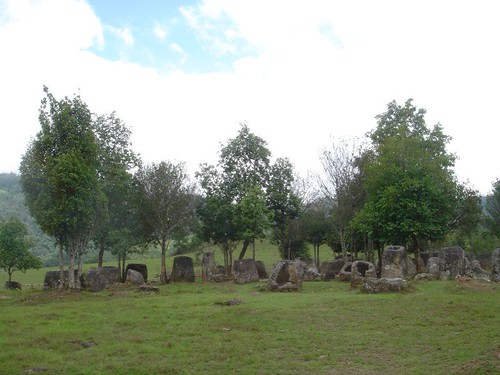 A country of rich cultural heritage and spectacular natural scenery, Cambodia has a sad recent history from which it is still picking up the pieces. From the former heights of the mighty 10th century Angkor Kingdom to the lows of Pol Pot's murderous regime that wiped out a quarter of the population, Cambodia has had an eventful past.
A country of rich cultural heritage and spectacular natural scenery, Cambodia has a sad recent history from which it is still picking up the pieces. From the former heights of the mighty 10th century Angkor Kingdom to the lows of Pol Pot's murderous regime that wiped out a quarter of the population, Cambodia has had an eventful past.What’s Cool
Angkor Wat, glitzy casinos, Sihanoukville's empty beaches, Phnom Penh's vibrant backpacker scene, Mekong Island's wildlife, dolphin spotting in Kratie, cheap hotel rates, interesting museums tracing Cambodia's tragic modern history.What’s Not
Widespread prostitution and poverty, unexploded ordinance, scams, hot and humid weather for most of the year, occasional violence and political tension, unreliable transport, pot holes, lawlessness and firearms.When to Go
Best: March-AprilWorst: November-December
Visas
US/Can: no (30 day)EU: *no (30 days)
Aus/NZ: no (30 days)
Essential Info
Time: GMT+7Electricity: 220V 50Hz 3-Pin Plug
Money: Baht: 1US$ = 32 Baht
Phone: ICC (+66) Outgoing: 001
Cambodia might be quite low-key compared to its more popular neighbor, Thailand, yet it has plenty of charms of its own. With ancient temples, fascinating ruins, peaceful beaches and the very touristy Angkor Wat, Cambodia is slowly making its way to becoming one of the more popular destinations in Southeast Asia.
The capital, Phnom Penh, caters well to backpackers with its budget lodgings and lively bars while the likes of Siem Reap have more upscale offerings to cater to the increasingly sophisticated Angkor Wat crowds. The macabre Killing Fields are a sombre reminder of the nation's turbulent past but essential viewing for anyone who wants to get to grips with Cambodia's turbulent modern history.Travel to Cambodia - Getting There
The fastest way to arrive in Cambodia is by air. The airport in Phnom Penh receives flights from Bangkok, Singapore, Kuala Lumpur, Hong Kong, Ho Chi Minh City and Guangzhou. From the airport, local buses are provided to take you to your destinations while taxis are aplenty at the airport and in the city. There are also frequently flights to Siem Reap from Bangkok, Chiang Mai, Pattaya and other regional airports - for convenient short trips to Angkor Wat. Alternatively, you can reach Cambodia by waterway from neighboring countries. The country's international seaport is located in Sihanoukville. To get around, use the services of trishaws and taxis. The road network is in a poor state and land transport is both tedious and uncomfortable.Cambodia Things to Do
Angkor Wat
- Siem Reap acts as the gateway to the world-renowned temples of Angkor, a true wonder of the world and the remains of an ancient Khmer city and religious center. The nearby Bayon and Ta Prohm temples are also worth visiting.
- Phnom Penh
- Many outstanding colonial architectural wonders, old temples, the National Museum, the Silver Pagoda, and busy streets attract tourists to Cambodia's capital city where unique historic charms fill the air.
- Mekong Island
- Visit a small zoo and weaving villages. Befriend big, friendly elephants and explore the island on their backs.
- Sihanoukville
- This resort town in the south boasts tranquil beaches, several natural spots such as waterfalls and rolling hills, and is a great place to relax with plenty of peaceful resorts.
- Battambang
- Cambodia's second-largest city, about 290kms from Phnom Penh, features many temples and villages. A small museum displays a selection of Angkor-era artifacts while a large lake is an ideal place for relaxing amid nature.
Cambodia Travel Guide

When Laos began to truly open to tourism in the early 1990’s, visitors focused on the cultural riches of Luang Prabang in the north, and the southern regions remained for a long time a destination for the more adventurous travelers. But this is changing fast. With the remarkable improvement of road networks around the whole of Indochina, Champasak has become the center of a new buoyant backpacking scene commuting overland in luxurious sleeper buses between Vientiane and Phnom Penh. And with a bridge crossing over the Mekong that links Thailand and Vietnam along the east-west axis, getting across borders is now much easier.
Sand Bar Islands

Mention visiting an island in Laos and one will most likely meet with a perplexed gaze. The very idea of islands in Southeast Asia is so indubitably linked to visions of white sandy beaches, that it simply cannot fit Laos, a largely mountainous country with no direct access to the sea. But rivers too can harbour islands, and in the case of Laos, one has to take into account that the Mekong isn’t just any ordinary river. It is one of the longest rivers in the world, and the possibility of it giving rise to islands shouldn’t be regarded as impossible. However, the Lao name Si Phan Don, or Four Thousand Islands, that was bestowed on the lush and scenic Champasak province in Southernmost Laos is a little superlative, if not far-fetched. To meet with such an incredible number of islands, one has to take into account every single sand bar that emerges out at the peak of the dry season. That said, there are indeed a good number of islands inhabited all year round, the largest of which, Don Khone, measures no less than four-by-eight kilometers. At the height of the rainy season, some parts of the Mekong in Si Phan Don can span over 12 kilometers. This is also where the river suddenly drops in altitude, resulting in the formation of a few majestic waterfalls that have prevented thorough commercial use of the Mekong. One of these waterfalls, Khon Pha Pheng, is purpotedly the largest waterfall in Southeast Asia and, indeed, the impressive tumultuous flow of water stands as a stark reminder that the Mekong is also the 12th largest river of the world by volume.
The Two Dons
The islands of Si Phan Don are best explored by bicycle, cycling on sandy shaded paths across the forests or along the luxuriant river banks. Most activity takes place on the twin islands of Don Det and Don Khone, which are linked by a concrete bridge. This bridge was part of a train track built by the French to link Don Khone’s southernmost point and Don Det’s northern bank in an attempt to bypass the waterfalls and allow the transportation of goods on the Mekong. A short distance away from the bridge lies a rusting tiny locomotive that for many years commuted along the only railway track ever built in Laos. Don Det has attracted the younger segment of the backpacking scene, bringing a distinct hippy flavor to the place. Typical accommodations here take the form of hammocks hanging in the bungalows veranda, with a view over the river of course. The more comfortable accommodations are found in Don Khone. An interesting option is Sala Phae (Ban Khone Tai, Khong District, Champassak Province, +856-30-525 6390, +856-21-217 526, www. salaphae.salalao.com), which has floating raft rooms, where you can sleep in a large breezy room directly over the flow of the mighty river, watch the sunset from the veranda, and dip your feet in the cool water of the Mekong.
Pakse Crossroads

Si Phan Don, however, is only one of the many attractions that Champasak has to offer. The once sleepy little town of Pakse is right in the middle of the Indochina backpacker trail, and seems bent on becoming an important crossroad. In fact, judging by the number of luxury hotels under construction around town, Pakse has already become an attractive destination for a number of investors. Pakse too has its fair share of quaint colonial buildings from the turn of the 20th century which are an interesting combination of Art Deco and 1950’s architecture. Particularly arresting is a block of shophouses where one can see a clear chronological evolution of urban Southeast Asian architecture over the entire 20th century, from French colonial to 1990’s Post-Modern and Neo-Classical styles. And, with a scenic location at the confluence of the Mekong and the Se Don River, Pakse is actually quite a pleasant place to visit.
The Bolaven Plateau

Just one hour north of Pakse, with an altitude of around 1,000 meters, the Bolaven plateau was put to good use by French planters to cultivate coffee and tea. Today, a large quantity of the production is exported, and is one of Laos’s most important sources of foreign trade. This is the place to find cool air and nature at its best. Ecotourism has become a catch word in Laos, heavily encouraged by local authorities, and the Bolaven plateau has a lot to offer. You can enjoy scenic rides across forests, coffee and tea plantations; hop from one pretty waterfall to the next, stop in hill tribe villages to buy intricate hand-woven textiles or take the obligatory elephant ride. More adventurous travelers can rent motorbikes to explore the plateau on their own. The Bolaven plateau also has a few atmospheric accommodation options to offer in the form of bungalows overlooking cool waterfalls.
The Ruins of Wat Phu

Champasak is home to one of the oldest Khmer sites in existence—the ruins of Wat Phu. The origin of this temple is found in the shape of the mountain at the foot of which the temple started taking shape in the fifth century CE. The summit, the Phu Kao, immediately commands ones attention because of its resemblance to a linga, Shiva’s phallic symbol. Phu Kao was believed to be a natural linga, a spontaneous manifestation of the Hindu god. At the foot of the mountain, fl owed a spring, around which the temple was built. Later in history, that spring was used to keep the linga of the sanctuary perpetually wet, a set-up apparently unique to the Khmer world. Wat Phu presents fine examples of Khmer sculpture and is best visited in the early morning when the frangipanis lining the staircase leading to the sanctuary pervade the air with their heavenly smell. In order to be there in time for sunrise, it is best to stay in the nearby little town of Champasak that gives its name to the province, which was previously the capital of a short-lived, 18th century kingdom that has lost most of its former glory. There are a few guesthouses of fairly good standard. The best and most romantic option is La Folie Lodge (Don Daeng, District Pathoumphone, BP 668, Champassak, Lao PDR., 856-534-7603, reservations@folie-laos.com), a resort complete with swimming pool overlooking the Mekong and finely decorated teak bungalows set in the lush greenery of the island of Don Daeng. As the whole of Indochine opens up ever more to tourism, there will be fewer and fewer places like Champasak left to explore. Go now.
Source: AziaCity.com
Champasak: Laos’s New Destination !

(KPL) A tourism information center was built recently in Parkbeng district with 287 million kip of government fund.
The center was considered as the main potential for attracting the tourist and helping them to save the time to looking for the tourist sites in the province.
In the first six months of 2007-2008 period, the Parkbang district has received 24,548 tourists, 1,140 of which was local tourists and 23,307 foreign tourists with able to create income about 6.137 billion kip.
To day, the Parkbeng district has one hotel, 2 resorts and 13 guesthouses with 216 rooms and 20 restaurants.
Tourism information center built in Pakbeng district, Laos
Welcome to Laos to watch the following story of Luang Prabang, the world heritage site.
Luang Prabang, the best preserved city in Southeast Asia
A landlocked Asian country of mountainous wilderness in the north, dense jungle in the east and the mighty Mekong River in the west and south, Laos is an unspoiled, largely rural country. Although this communist land remains among the world's poorest nations, Laos offers a glimpse into a timeless and forgotten Asia.
What’s Cool
Floating down the Mekong on an inner tube, Luang Prabang's hundreds of temples, the mysterious Plain of Jars, French style baguettes and Lao coffee, boating around the 4,000 Island, Vientiane's Morning Market, the lush forests of the Bolaven Plateau, the slow pace of life.What’s Not
Old and unreliable buses, pot holes the size of a car, towns that seemingly go to bed at sunset, dust, scorching temperatures in the hot season, unexploded ordinance, poor food hygiene.When to Go
Best: October-FebruaryHigh season: November to February, April
Low season: June to October
Visas
US/Can: on-arrival (15 day)EU: on-arrival (15 days)
Aus/NZ: on-arrival (15 days)
Essential Info
Time: GMT+7Electricity: 220V 50Hz
2 prong round or flat pins
Money: Lao Kip
1US$ = 8,400 Kip
Phone: ICC (+856) Outgoing: 00
Precious hidden gems including temple-clad Luang Prabang and the old-fashioned capital city of Vientiane as well as many historical and natural wonders make Laos a cheap and newly popular destination for adventurers. The busiest tourist hotspots have seen old colonial mansions come back to life as boutique hotels while restaurants have cashed in on the French connection.
Travelers wishing to get off the beaten track of this slow-moving country can head for the mysterious Plain of Jars, a protected landscape dotted with huge jars carved out of stone, the origin of which is debated. Adventurous travelers should think twice about straying too far off the tourist track however, as unexploded ordinance from the Vietnam War era still plagues the nation.Travel to Laos - Getting There
There are flights connecting Vientiane's Wattay Airport to Bangkok, Ho Chi Minh City, Phnom Penh, Yangon and Kunming . Alternatively there is a service from Chiang Mai to Luang Prabang. Vientiene is also easily accessible by bus and train from Bangkok via Udon Thani. Catching the boat down the Mekhong from Northern Thailand is a popular adventure. Within the country buses are the only transport options, they are slow and hardly comfortable but usually make it over the mountainous terrain.Laos Things to Do
Luang Prabang
- Charming former capital, now a UNESCO World Heritage site boasting many beautiful Buddhist temples, French-era colonial houses and must-visit spots such as Phusi - a steep hill overlooking scenic views of the town - the Royal Palace Museum and Wat Xieng Thong, a fine example of Lao architecture.
- Vientiane
- Low-key capital city features an array of historic buildings including That Luang chedi and temple complex, (the national symbol of Laos), the Pataxi - a neo-Arch de Triomphe, Wat Sisaket and Wat Haw Pra Keo.
- Champasak Province
- Cruise down the Mekong and explore the 'four thousand islands' at the river's widest point, or hire a three-wheeled tuk-tuk to explore the town which was once a part of the Khmer Angkor Empire.
- Vang Vieng
- Cool stopover en-route south to Vientiene, popular with backpackers for its free-spirited atmosphere, impressive hilly backdrop, lazy river and exciting caving.
- Muang Sing
- Home to Laos' most colorful hill tribe people as well as several opium dens.
- Plain of Jars
- In the country's centre is scattered with bizarre massive ancient jars, the origin of which has baffled many.
- The Bolaven Plateau
- In Saravan, boasts gorgeous waterfalls and lush forests, the small market here is worth a visit.
Laos Travel Guide
Discover the Jewel of the Mekong river, Laos, by the Lao National Tourism Administration
Laos, the Jewel of the Mekong river (Official video 2008)

Xieng Khuang provincial authorities are hoping to open the door to the province's tourist attractions with two important new keys.
The first is the promotion of the Plain of Jars as a World Heritage Site in 2010 and the second is the construction of an international airport.
Xieng Khuang provincial Tourism Department Director, Mr Khamphet Phommadouangkaison, said “Our province has two big keys to open the door of worldwide tourism promotion.”
“Our vision for the development of our tourist attractions is to make changes in a logical way and follow the slogan ‘a smoke-free tourist industry',” he added.
“The province ranks tourism as second in importance to livestock rearing in its development master plan.”

“At present we are working on documents relating to the Plain of Jars which we will send to the United Nations Educational, Scientific and Cultural Organisation (UNESCO). We hope to have finished all the documents soon and they should be approved by UNESCO by 2010,” Mr Khamphet said.
“We plan to upgrade the provincial airport to an international airport in the near future. The project is now under discussion and we will send a project proposal to the government.”
Another of the province's plans is to develop the 750ha hill on Koud Mountain in Phoukoud district into a new tourist attraction, with a possible opening in 2009.
The Acting Governor of Xieng Khuang province, Mr Viengthanom Phommachanh, said last week the airport expansion would be financed by a loan from a neighbouring country worth about US$50 million.
He said this development would start in the near future because it was very important in bringing more tourists to the province.
“If we have better transport facilities we will get more tourists here. Most of them want to make short trips to local areas of interest so they have more time to spend at the site they visit,” Mr Viengthanom said.
According to a report from the Xieng Khuang provincial Tourism Department, there are actually 1,900 jars scattered over 52 sites, but only three sites are open to the public - two in Kham district and another in Khoun district.
The province has 14 hotels and more than 40 guesthouses.
Most visitors to the province come from Europe, with the rest coming mostly from Japan , China , Vietnam and Thailand .
By Sisay Vilaysack
Vientianetimes
Plain of Jars to become new World heritage site in 2010
Đăng ký:
Bài đăng
(
Atom
)





.jpg)

